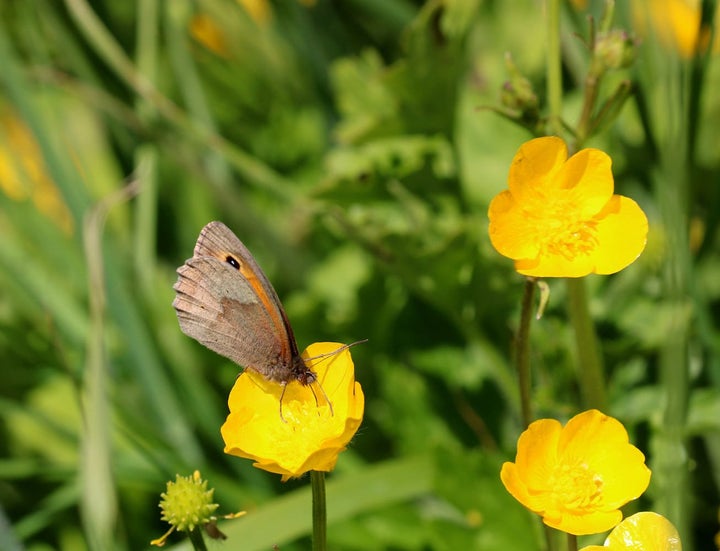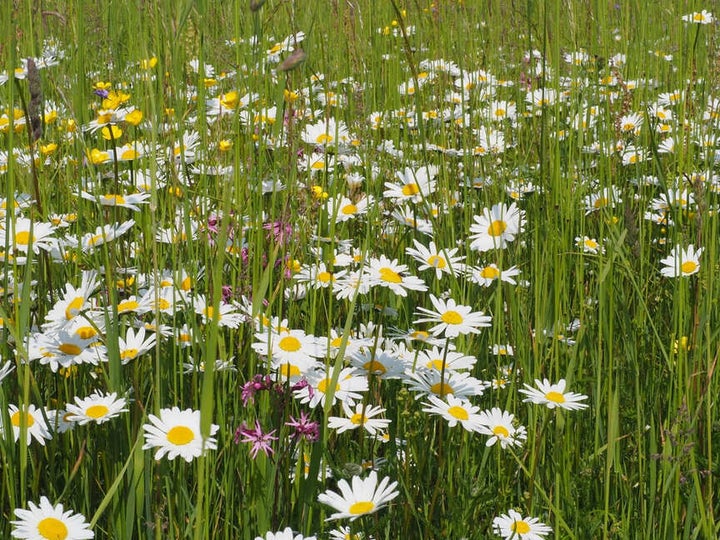
Quick facts
Creeping buttercup’s botanical name is Ranunculus repens
It is a herbaceous perennial and a UK native wildflower
Like other species of buttercup, plants are harmful if eaten and can cause skin irritation
Creeping buttercup supports a range of wildlife, including bees, butterflies and beetles
If you need to control creeping buttercup, non-chemical methods are effective
What does creeping buttercup look like?
Creeping buttercup can reach a height and spread of 50cm (20in). The leaves are divided into three deeply lobed leaflets with serrated edges, and they sometimes have pale markings. Small, pale hairs cover both the leaves and stems.
Five-petalled, glossy yellow flowers appear in late spring and summer, continuing into autumn if growing conditions are favourable. Creeping buttercup is true to its name in habit, sending runners (low, rooting stems) outwards from the main plant. It also produces dense clumps of deep, pale roots.

Did you know?
The botanical name Ranunculus comes from the Latin words “rana” meaning frog, and “unculus” meaning little. It is thought they were named after “little frogs” because many species, including Ranunculus repens, thrive in wet soils near streams, rivers or ponds.
Is creeping buttercup a weed?
Some gardeners deliberately introduce creeping buttercup into their gardens because it is an attractive . Its bright yellow flowers, held on strong, branching stems, make an attractive addition to wildflower meadows and species-rich lawns. It is a tough and adaptable plant, growing well in wet conditions and being able to withstand periods of waterlogging, yet also coping with dry spells thanks to its deep roots.
Creeping buttercup is a great plant for wildlife, with its nectar and pollen rich flowers attractive to bees, butterflies and hoverflies. For this reason it is included on the RHS Plants for Pollinators list. Creeping buttercup is also a food plant for a range of other creatures, including beetles, leafhoppers, leaf mining flies and birds.


Did you know?
The glossy petals of buttercup flowers warm the centre of the flower and reflect ultraviolet light to attract pollinating insects, thereby increasing the likelihood of fertilisation. The petals also reflect sunlight if held under your chin, regardless of whether or not you like butter!
Gardeners wishing to maintain a fine, are, however, likely to view creeping buttercup as a weed. It’s spreading habit also makes it unwelcome in manicured borders where it could compete with border plants for moisture, nutrients, space and light, and could potentially smother smaller plants.
What is a weed?
The term ‘weed’ describes a plant that is growing where it isn’t wanted. Weeds usually thrive in average garden conditions, reproducing and spreading easily. It is up to you to decide what you call a weed and what you choose to retain or remove.
Frequently asked questions about controlling creeping buttercup
Here are our answers to your most common questions about dealing with creeping buttercup:
How invasive is creeping buttercup?
Creeping buttercup spreads by both seed and runners and can quickly creep to form a large carpet. In summer and autumn, much of the ripe seed lands near the parent plant, although wind and birds can transport seed further. In damp soils, creeping buttercup grows strongly and quickly, spreading by runners that produce roots and shoots along their length. New plants establish quickly with a deep, dense, fibrous root system, and both roots and runners can grow into nearby plants.
As a short section of runner with a node (growing point) can regenerate, gardeners may unintentionally spread creeping buttercup by distributing small sections of runners when digging or moving plants, or by using garden compost to which runners were added.
Do I need to get rid of creeping buttercup?
No – creeping buttercup is an attractive, wildlife-friendly plant and allowing it to grow in a species-rich lawn, wildflower meadow, wildlife corner or in a container is a great way to boost in your garden.

However, as creeping buttercup is capable of outcompeting and smothering smaller or less vigorous plants, it is a good idea to manage its spread. You may want to remove it entirely from fine lawns, veg patches, seedbeds, alpine rockeries or other highly cultivated beds and borders.
What is the easiest way to kill creeping buttercup?
If you have creeping buttercup growing where it is not wanted, there are methods of controlling it:
In lawns
- Improve lawn health – if creeping buttercup is a problem in your lawn, follow a good spring/summer and autumn maintenance regime to boost grass vigour and fill gaps, making it harder for creeping buttercup to take hold and spread. Wet or lawns will favour creeping buttercup, so focus on , reducing compaction and improving drainage if you have these conditions.
- Rake before mowing – rake over areas where creeping buttercup is growing to lift the developing runners or low-lying flowering stems, so the mower can cut, collect and remove them. This will prevent self-seeding, reduce their spread by runners and help weaken individual plants.
- Fork out plants - use a hand fork or border fork to lift out clumps of creeping buttercup, making sure to remove recently rooted sections along runners too. Re-seed resulting patches of bare soil.
In beds and borders
- Adjust growing conditions – improving drainage will make growing conditions less favourable for creeping buttercup.
- plants – remove fading flowers before they set seed. Deadheading will greatly reduce the amount of creeping buttercup in your garden.
- Hoe off seedlings – sharply slide the blade of a hoe just under emerging seedlings to kill the whole plant. Hoe on a warm, dry or windy day, so exposed roots dry out quickly. Seedlings are most likely to appear in spring and summer.
- Fork or dig out plants – remove young plants and recently rooted sections along runners with a hand fork or trowel. Use a border fork or spade to lift out large, established clumps, inserting it deep enough to remove as much of the root system as possible.
- Clear beds and replant – where creeping buttercup is widespread within a border, it may be necessary to lift your border plants and remove any intertwined roots or runners of creeping buttercup, before replanting into cleared soil. This is best done between late autumn and early spring, when most border plants are .
- Smother plants – if creeping buttercup growth is dense in an area, cut back the top growth and cover the soil with cardboard and a thick 20cm (8in) layer of organic matter, such as or wood chips. Alternatively, use a heavy grade matting. This will block light and prevent growth, causing the root system to die. Keep soil covered for a few years, topping up the mulch layer if necessary, to ensure this method is effective. This is a good option for maintaining soil health as it limits disturbance.
Top Tip
Don’t add creeping buttercup to your home compost bin, as it may not reach high enough temperatures to kill stems, runners, roots and seed. Instead, put it in your council green waste recycling bin or take it to your local recycling site.
Should I use weedkiller?
No – as non-chemical control methods are effective, even if time-consuming, there is no need to use weedkillers.
For more information, see our page on Weeds: non-chemical controls.











